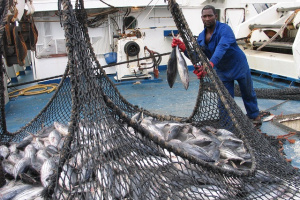Possible effects of El Nino on yellowfin tuna catch in Seychelles, says fisheries minister
Fisheries |Author: Alisa Uzice Edited by: Betymie Bonnelame | April 11, 2024, Thursday @ 10:19| 32574 views
Seychelles had a total quota of 33,200 tonnes for this species of tuna. (Joe Laurence, Seychelles News Agency)
(Seychelles News Agency) - The effects of El Nino may have impacted the amount of yellowfin tuna caught during 2023 and last year in Seychelles, according to the country's minister for fisheries.
Seychelles had a total quota of 33,200 tonnes for this species of tuna, which is subject to a strict quota system monitored by the Indian Ocean Tuna Commission (IOTC).
This amount is then distributed by the Seychelles Fisheries Authority (SFA) to 13 Seychelles-flagged longliner vessels, each receiving about 2,400 tonnes for the year.
Yellowfin tuna in the Indian Ocean is currently the most overfished tuna stock in the world and this is why in 2016, the IOTC adopted a resolution reducing the fishing allowance of the species by 15 percent to help rebuild the population.
The Minister for Blue Economy and Fisheries, Jean-Francois Ferrari, told SNA, "At the moment SFA is still in the process of crunching the numbers so we don't have a final answer yet. However, for 2023 we expect to be under-quota and several factors may have caused this. According to our scientists, El Nino could have played a part in this because when sea temperatures rise the tuna tend to swim at lower depths."
Every year, the Seychelles-flagged vessels are legally required to declare their catch for the year on December 31 and usually vessels start reaching their limit towards the end of October or beginning of November, but this is vessel-specific as they each one manages its quota differently.
In the past, some have chosen to do their major servicing during the stoppage and go to dry-docking in Mauritius or Madagascar, while some remain in Seychelles and undertake minor routine servicing on equipment.
Fishing operations usually are expected to resume as of January 1 once quotas are reinstated, while some vessels will leave port as early as December 28 to be able to start operations as the New Year rolls in.
However, this year, since the vessels were behind on their quota, they were still at sea until the end of December. To ensure that these vessels did not miss the start of the season at the beginning of January, they were allowed to remain at sea and granted permission to declare their catch for 2023 two weeks later on January 15.
Ferrari said, "The vessels had to ensure that the new catch for 2024 was kept separate from the one from 2023 to ensure that the quota is properly recorded. There were also observers present that ensured that these processes were followed adequately."
Fisheries is the second top contributor to the economy of Seychelles, an archipelago in the western Indian Ocean.
Back
